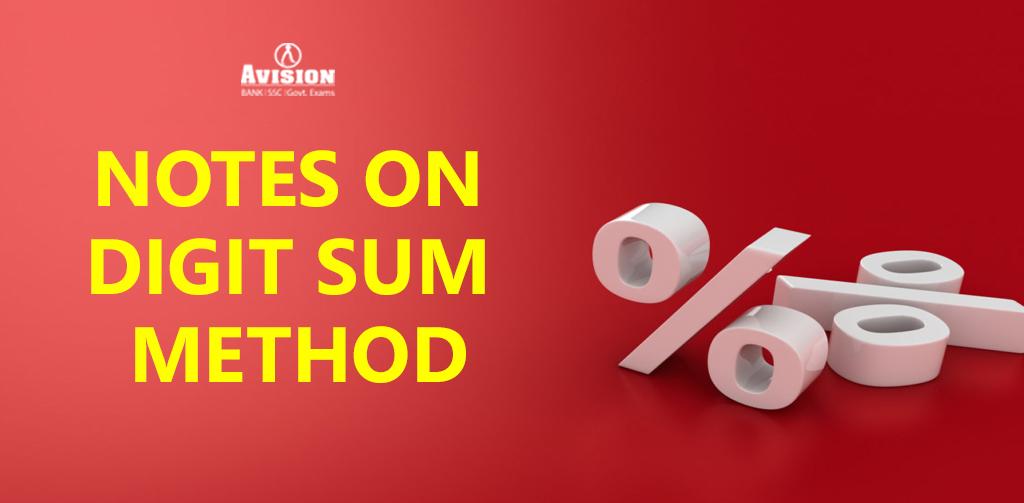
Quantitative Aptitude is hard in most cases especially in exams like Banks and Insurance. Many Banks exam has a two-tier examination pattern i.e., Prelims and Mains. Most of them have changed their exam patterns and set a sectional timing of 20 minutes on each section. Quantitative aptitude is important for every exam because proper strategy and enough practice can help you score full marks in this section. There may not be assured in the language section and you may be stuck while solving reasoning questions but quants is a scoring subject and assure full marks if the calculation is correct.
So to help you ace the quants and to save your precious time during exam hours Adda247 providing some quant tricks to help aspirants.We are stating with rules of digit- sum method.Rules of digit-sum method This method is also called the nines- remainder method1. We get the digit-sum of a number by adding across the number. for eg, the digit-sum of 13022 is 1+3+0+2+2=82. We always reduce the digit-sum to a single figure. for eg, the digit-sum of 5264 is 5+2+6+4=17
but reduce it to single figure i.e 17 is reduced to a single figure i.e. digit sum of 1+7=8.3. Note- In adding across a number we may drop out 9, 9 doesn’t count on digit sum.
eg1: digit sum of 9901is (0+1)= 1.eg2: digit sum of 279 is (2+7+9)= 0 here digit sum of (2,7) makes 9.4. for decimals we work exactly the same way, but we don’t pay attention to the decimal points.the digit sum of 6.256 is (6+2+5+6)=19, neglect 9= digit sum is 1We apply digit sum for addition, subtraction, multiplication, division.Digit sum plays a crucial role in simplification in option elimination.For addition-
Eg1. 1.5+32.5+23.9= 57.9
LHS-digit sum(1+5)+ (3+2+5)+(2+3)= 6+10+5=21=3RHS- 5+7+9= 5+7=12=3(LHS)= (RHS)Eg2. 23+48=71LHS=digit sum(2,3)+(4,8)=5+(12)= 5+3=8RHS= 7+1=8LHS=RHSEg3. 321+467+2311= 3099LHS=(3+2+1)+(4+6+7)+(2+3+1+1)= 6+(17)+(7)=6+8+7=21=3RHS=3+9+9 treated 9 as 0= 3LHS=RHSFor Subtraction
Eg1. 93-21=72
LHS- digit sum of (9+3)-(3)=3-3=0RHS-7+2=9 i.e. 0LHS=RHSEg2.- 140-80=60LHS- (1+4)-(8)= 5-8= -3 when digit sum is negative add 9 in ithere -3+9= 6RHS- (6+0)=6LHS=RHSFor Multiplication-
Eg1. 15*13=195
LHS-digit sum of 15 and 13= 6*4=24=6)RHS- 195= 6LHS=RHSOr we can do it by-15*13= any number has 5 in its unit digit make it to 10 by multiplying by 2 and further divide by 2 to balance.15*13= (30*13)/2=390/2=195.Note- digit sum very helpful in long multiplication Eg2. 321*132= 42372LHS- digit sum of 321 is 6 and 132 is 66*6=36 i.e 9 we neglect 9= 0RHS- digit sum of (4+2+3+7+2)=0LHS=RHSFor Divison
The rule of digit-sum fails in some cases when the denominator has 3,6,9.
in this case, better is to divide the number first to remove the denominator.
1. 38982/73= 534( Digit sum is 3)the digit sum of 38982 (3+8+9+8+2) i.e 373= digit sum is 10 i.e. 13/1=3(LHS)LHS=RHS2. (4848/24)*11-222= 2000here denominator digit sum is 2+4=6here digital sum can’t apply directlybetter to divide first to eliminate denominator(4848/24)= 202now apply digit sum202*11-222= 4*2-6=2(LHS)For RHS= 2000= 2.Note- Digital sum method is not used in the approximationDo it Yourself- Some example where digit sum is very helpful 1. 35% of 60% of 3/5*275001. 33452. 33553. 34654. 43612. 48% of 4800+24% of 12601. 2606.402. 2556.653. 2566.564. 2286.1

Leave a Reply